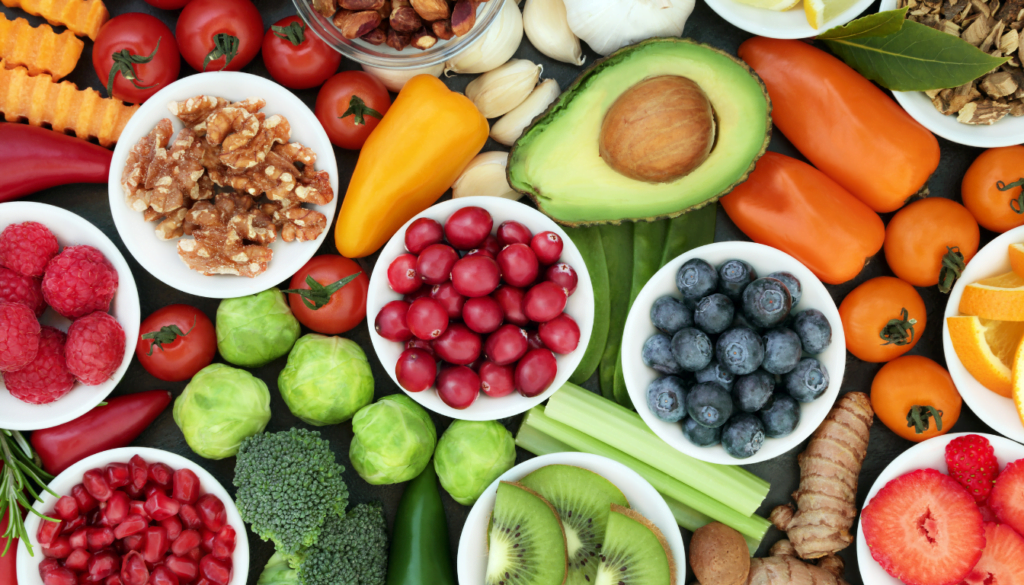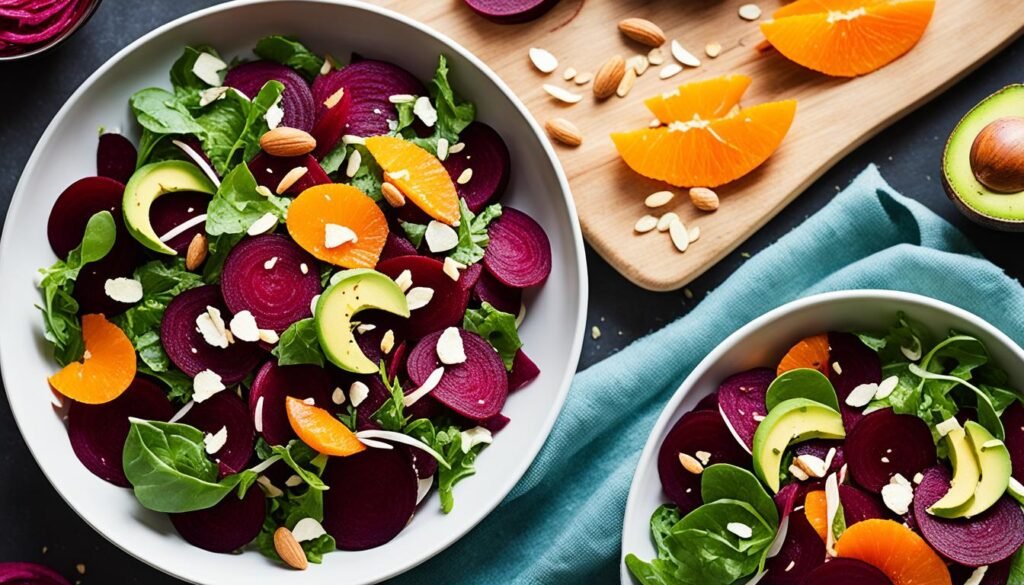Gaining popularity for its holistic approach to nutrition and well-being, Ayurveda offers a unique way to create balanced meals that nourish the body and promote overall harmony. In this article, I will explore the principles of Ayurvedic cooking and share some delicious lunch recipes that incorporate Ayurvedic ingredients to support your dosha balance and provide a wholesome eating experience.

Ayurvedic lunch recipes are not just about what we eat, but also how we prepare and consume our meals. Ayurvedic cooking emphasizes the use of fresh and seasonal ingredients, mindful eating practices, and the importance of creating meals that appeal to all our senses. By following Ayurvedic principles, we can not only satisfy our hunger but also promote physical and mental well-being.
Table of Contents
Key Takeaways:
- Ayurvedic lunch recipes focus on creating balanced meals that support your dosha balance and promote overall well-being.
- These recipes incorporate Ayurvedic principles and utilize fresh and seasonal ingredients.
- Ayurvedic cooking emphasizes mindful eating practices and the importance of creating a sensory experience during mealtime.
- By embracing Ayurvedic lunch recipes, you can nourish your body, support holistic nutrition, and promote balance in your daily life.
- Explore the upcoming sections to discover delicious Ayurvedic lunch recipes and begin your journey towards a more wholesome and balanced eating experience.
Understanding Ayurvedic Eating Principles
Ayurveda, an ancient Indian practice, places great emphasis on maintaining overall well-being through various aspects of life, including diet. One of the key components of Ayurvedic living is Ayurvedic eating, which focuses on balancing the three doshas – Vata, Pitta, and Kapha – through conscious food choices. Understanding and harmonizing these doshas is vital for promoting optimal health and achieving balance in our lives.
The three doshas in Ayurveda represent different qualities and energies, and each person has a unique combination of these doshas that influences their physical, mental, and emotional well-being. Here is a brief overview of the three doshas:
- Vata: Represented by the elements of air and space, Vata governs movement, creativity, and flexibility. When in balance, Vata individuals are energetic, imaginative, and adaptable. However, an excess of Vata can lead to anxiety, dryness, and digestion issues.
- Pitta: Associated with the elements of fire and water, Pitta governs metabolism, digestion, and transformation. Pitta individuals tend to have strong digestion, focus, and leadership qualities when in balance. Imbalances can manifest as irritability, inflammation, and excessive heat in the body.
- Kapha: Comprising the elements of earth and water, Kapha governs structure, stability, and nourishment. Balanced Kapha individuals are calm, grounded, and supportive. Imbalances may result in weight gain, lethargy, and congestion.
Ayurvedic eating aims to balance these doshas by incorporating foods and cooking techniques that help alleviate excesses and nourish deficiencies. It recognizes that different foods have different qualities and energies that can either aggravate or pacify specific doshas.
For example, Vata individuals benefit from warm, grounding foods like cooked grains, root vegetables, and hearty stews to counterbalance their airy and mobile nature. Pitta individuals thrive on cooling and hydrating foods like leafy greens, cucumber, and coconut to balance their fiery temperament. Kapha individuals benefit from light and warming foods like spices, bitter greens, and legumes to counteract their tendency towards heaviness and stagnation.
Ayurvedic eating is based on the principle of balance – maintaining equilibrium in the doshas leads to a harmonious state of health and well-being.
By understanding your unique dosha composition, you can personalize your diet to find balance and support your overall health. Ayurvedic eating encourages mindfulness, listening to your body’s needs, and making conscious choices that promote well-being. It’s a holistic approach to nutrition that recognizes the interconnectedness of body, mind, and spirit.
In the next section, we will delve deeper into finding your dosha and understanding the specific dietary recommendations for each dosha type.
Finding Your Dosha
Understanding your dominant dosha is crucial in Ayurvedic eating. By identifying your body type and the dosha that is most dominant in you, you can make food choices that help balance all three doshas. It’s important to note that Ayurvedic eating is not about solely consuming foods associated with your dominant dosha, but rather achieving balance by incorporating foods from all doshas.

Identifying Your Dominant Dosha
In Ayurveda, individuals are categorized into three doshas: Vata, Pitta, and Kapha. These doshas represent different energy types, each with its own set of qualities and characteristics. To determine your dominant dosha, you can consider various factors such as your physical attributes, personality traits, and behaviour patterns.
- Vata: If you tend to have a slender frame, dry skin, and a preference for movement and change, you may have a dominant Vata dosha.
- Pitta: Those with a medium build, warm skin, and an ambitious and focused nature often exhibit dominant Pitta characteristics.
- Kapha: If you have a sturdy build, smooth skin, and a calm and stable demeaner, your dominant dosha may be Kapha.
Keep in mind that while you may have a prominent dosha, everyone possesses all three doshas in varying degrees. Achieving dosha balance involves understanding your unique constitution and making choices that support overall harmony.
Maintaining Dosha Balance
Once you have identified your dominant dosha, you can make informed dietary choices to help balance all three doshas. Ayurvedic eating recommends incorporating foods from all doshas to achieve optimal health and well-being. This approach helps address any imbalances and promotes harmony within the body.
“Just as harmony requires a balance of different notes in music, our bodies thrive when we harmonize the qualities of all three doshas through our food choices.” – Dr. Deepak Chopra
For example, if you have a dominant Vata dosha, you can incorporate grounding foods from the Kapha dosha, such as root vegetables and dairy, to balance out the light and airy attributes of Vata. Similarly, if you have a dominant Pitta dosha, you can include cooling foods from the Kapha dosha, like cucumbers and melons, to counterbalance the heat and intensity of Pitta.
By understanding your dominant dosha and embracing a diverse range of foods, you can create a diet that supports dosha balance and promotes overall well-being.
Ayurvedic Porridge Recipe
Ayurvedic porridge is a nourishing and balanced breakfast option, especially for Vata and Pitta types. This recipe combines cooked grains, like oats or rice, with warming spices and nourishing additives like nuts and fruits. Porridge supports digestion and provides sustained energy throughout the morning while helping to balance the doshas.
“Ayurvedic porridge is a delicious and comforting way to start your day. It not only provides essential nutrients but also helps create a sense of grounding and stability,” says Ayurvedic expert Dr. Priya Sharma.
Start your day off right with this Ayurvedic porridge recipe that balances the doshas and nourishes your body and mind.
Ingredients:
- 1 cup cooked grains (such as oats or rice)
- 1 cup plant-based milk (such as almond or coconut milk)
- 1 tablespoon ghee or coconut oil
- 1 tablespoon honey or maple syrup
- 1/4 teaspoon cinnamon
- 1/4 teaspoon cardamom
- A handful of chopped nuts (such as almonds or walnuts)
- A handful of chopped fruits (such as berries or bananas)
Instructions:
- In a saucepan, heat the ghee or coconut oil over medium heat.
- Add the cooked grains and sauté for a couple of minutes until lightly toasted.
- Stir in the plant-based milk, cinnamon, and cardamom.
- Simmer the mixture for 5-7 minutes, stirring occasionally, until the porridge reaches your desired consistency.
- Remove the saucepan from heat and let the porridge cool slightly.
- Transfer the porridge to a bowl and garnish with chopped nuts and fruits.
- Drizzle honey or maple syrup on top for a touch of sweetness.
- Serve warm and enjoy!
Start your day with this nourishing Ayurvedic porridge to support digestion and balance your doshas. Customize the recipe with your favourite toppings and spices to create a breakfast that suits your taste and Ayurvedic needs.
Golden Milk: An Ayurvedic Beverage
When it comes to Ayurvedic beverages, golden milk, also known as turmeric latte, is gaining popularity for its numerous health benefits. This warm and comforting drink combines the healing properties of turmeric with the nourishing qualities of milk, making it a perfect addition to your daily routine.
Turmeric, a vibrant yellow spice, holds a special place in Ayurveda for its powerful anti-inflammatory and digestive properties. It contains a compound called curcumin, which is known for its antioxidant and immune-boosting effects. Including turmeric in your diet can help support overall well-being and promote a healthy immune system.
Golden milk is typically prepared by combining turmeric, milk (dairy or plant-based), and a touch of sweetness, such as honey or maple syrup. To heighten the absorption of curcumin, it is often recommended to add a pinch of black pepper, which enhances its bioavailability.
The warm and soothing nature of golden milk makes it a fantastic drink to enjoy during cooler seasons or as a bedtime ritual. It not only helps you relax but also aids in digestion, making it an ideal choice after a meal. The natural sweetness and earthy flavours of turmeric bring comfort and balance to your senses.
For those who prefer a dairy-free option, golden milk can be prepared using nut milk, such as almond or coconut milk. These alternatives provide added creaminess and complement the earthy flavours of turmeric, creating a delicious drink that suits different dietary needs.
Health Benefits of Golden Milk:
- Anti-inflammatory properties help reduce inflammation in the body
- Aids digestion and supports a healthy gut
- Boosts the immune system and helps fight off infections
- Provides antioxidant protection against free radicals
- Promotes a sense of calm and relaxation
- Supports joint health and may alleviate pain and stiffness
Golden milk, with its warm and nourishing qualities, has been treasured in Ayurveda for centuries. Incorporating this Ayurvedic beverage into your daily routine is a delicious way to promote overall well-being and enjoy the many health benefits of turmeric.
Discover the natural goodness of golden milk and experience the healing power of Ayurvedic spices. Treat yourself to a cup of this soothing beverage and embrace the comforting flavours of turmeric latte.
Ayurvedic Dal Recipe
Dal, a traditional Indian dish made with lentils and spices, is highly recommended in Ayurveda for its ability to balance all three doshas. This versatile and comforting dish can be enjoyed on its own or combined with rice to create kitchari, a cleansing dish that supports digestive health. Dal is not only delicious but also provides a good source of protein, fibre, and essential nutrients, making it a nourishing choice for any meal.
To prepare Ayurvedic dal, you will need the following ingredients:
- 1 cup lentils (any variety)
- 3 cups water or vegetable broth
- 1 tablespoon ghee or coconut oil
- 1 small onion, finely chopped
- 2 garlic cloves, minced
- 1 teaspoon grated ginger
- 1 teaspoon turmeric powder
- 1 teaspoon cumin powder
- 1 teaspoon coriander powder
- ½ teaspoon chili powder (optional)
- Salt to taste
- Fresh cilantro for garnish
Here’s a step-by-step guide to preparing Ayurvedic dal:
- Rinse the lentils thoroughly and drain.
- In a large pot, heat the ghee or coconut oil over medium heat.
- Add the chopped onion, minced garlic, and grated ginger. Sauté until the onion is translucent.
- Add the turmeric powder, cumin powder, coriander powder, and chili powder (if desired). Stir well to coat the onions and spices.
- Add the rinsed lentils to the pot and stir to combine with the spices.
- Pour in the water or vegetable broth and bring to a boil.
- Reduce the heat to low, cover the pot, and let the dal simmer for about 20-25 minutes or until the lentils are tender.
- Season with salt to taste.
- Garnish with fresh cilantro.
You can enjoy Ayurvedic dal on its own as a soup-like dish or serve it with steamed rice or whole grain bread for a more substantial meal. The combination of lentils and grains provides a complete source of protein and creates a balanced meal that supports healthy digestion and overall well-being.
By incorporating Ayurvedic dal into your diet, you can experience the nourishing benefits of this cleansing food while enjoying a flavourful and satisfying meal.
Ayurvedic Beetroot Salad
Beetroot salad is a refreshing and colourful dish that can be easily prepared according to Ayurvedic principles. Beets, with their vibrant hue and earthy flavour, are a key ingredient in this nutritious salad.
Beets are known for their cleansing properties, making them an ideal choice for promoting dosha balance. They are rich in essential nutrients like vitamins A, C, and K, as well as minerals like potassium and iron.
To enhance the flavours and benefits of this Ayurvedic salad, you can add other Ayurvedic ingredients such as fennel, mint, and citrus fruits.
Benefits of Ayurvedic Beetroot Salad:
- Supports dosha balance: Beets are believed to help balance all three doshas, making them suitable for all body types.
- Cleansing properties: The detoxifying qualities of beets aid in purifying the blood and supporting liver function.
- Rich in antioxidants: Beets contain antioxidants that help protect the body against free radicals and promote overall health.
- Boosts digestion: The fibre content in beets helps regulate digestion and promotes a healthy gut.
- Provides essential nutrients: Beets are a good source of vitamins, minerals, and dietary fibre, contributing to a well-rounded diet.
Here’s a simple yet flavourful recipe for Ayurvedic beetroot salad:
Ayurvedic Beetroot Salad Recipe:
- Ingredients:
- 2 medium-sized beets, peeled and grated
- 1 small fennel bulb, thinly sliced
- Handful of fresh mint leaves, chopped
- 1 orange, segmented
- 1 tablespoon lemon juice
- 1 tablespoon extra virgin olive oil
- Salt and pepper to taste
- Instructions:
- In a large mixing bowl, combine the grated beets, sliced fennel, chopped mint leaves, and orange segments.
- In a separate small bowl, whisk together the lemon juice, extra virgin olive oil, salt, and pepper.
- Pour the dressing over the salad mixture and toss gently to combine.
- Let the salad marinate for at least 15 minutes to allow the flavours to meld together.
- Serve chilled and enjoy as a nutritious side dish or a light lunch.

This vibrant and nourishing Ayurvedic beetroot salad is not only visually appealing but also packed with beneficial ingredients that support dosha balance and overall well-being. Incorporate this salad into your Ayurvedic meal plan to add a burst of colour and flavour while enjoying the health benefits it has to offer.
Ayurvedic Stir-Fried Vegetables
Stir-fried vegetables are a versatile and adaptable dish that perfectly aligns with Ayurvedic cooking principles. This delicious recipe allows you to customize the dish according to the season and your individual dosha balance, ensuring a harmonious and nourishing meal. By incorporating fresh, seasonal produce, you can maximize the nutritional benefits and savour the flavours of nature’s bounty.
One of the key tenets of Ayurvedic cooking is the use of seasonal produce. This not only ensures that you are consuming ingredients at their peak freshness and flavour but also allows you to tap into the inherent wisdom of nature. Ayurveda recognizes that different seasons have varying impacts on our bodies, and by embracing the produce of each season, we can support our overall well-being.
When preparing stir-fried vegetables, consider incorporating a variety of colourful vegetables that are abundant during that particular season. For example, during the summer, you can include crisp bell peppers, juicy tomatoes, and crunchy zucchini. In the winter months, opt for root vegetables like carrots, sweet potatoes, and beets. By selecting vegetables in harmony with the season, you can truly experience the vitality and energy that comes from consuming nature’s bounty.
Here’s a simple recipe for Ayurvedic stir-fried vegetables:
- Heat a tablespoon of ghee or coconut oil in a pan over medium heat.
- Add your choice of vegetables, such as broccoli, bell peppers, carrots, and cauliflower.
- Sauté the vegetables until they are tender yet still retain a slight crunch.
- Season with Ayurvedic spices like cumin, coriander, and turmeric to enhance the flavour and therapeutic benefits.
- Optional: Add a sprinkle of sesame seeds or roasted peanuts for extra crunch and flavour.
- Serve the stir-fried vegetables as a side dish or as a main course with steamed rice or quinoa.
Enjoy the vibrant colours, delightful textures, and nourishing qualities of this Ayurvedic stir-fried vegetable dish. Let the wisdom of Ayurveda guide your food choices as you create meals that are both delicious and supportive of your dosha balance.
| Benefits of Ayurvedic Stir-Fried Vegetables |
|---|
| Promotes dosha balance |
| Provides a variety of essential nutrients |
| Enhances digestion |
| Supports overall well-being |
| Showcases the flavours and textures of seasonal produce |
Ayurvedic Grain Bowl
Grain bowls are a delicious and nutritious option for an Ayurvedic lunch. They provide a balanced meal by combining grains, vegetables, proteins, and flavourful dressings. By incorporating Ayurvedic ingredients and principles, you can create a grain bowl that not only satisfies your taste buds but also supports your overall well-being.
Building a Balanced Grain Bowl
Creating an Ayurvedic grain bowl involves layering different ingredients to ensure a harmonious blend of flavours, textures, and nutrients. Here’s a simple blueprint to guide you:
- Choose your base: Start with a grain as the foundation of your bowl. Opt for whole grains like quinoa, brown rice, or millet, which provide fibre and sustained energy.
- Layer on the vegetables: Add a variety of colourful vegetables to your bowl. Aim for a mix of cooked and raw options to incorporate both warming and cooling qualities.
- Add a protein source: Include a plant-based protein like tofu, tempeh, or beans to ensure a well-rounded meal. These protein sources provide essential amino acids while aligning with Ayurvedic principles.
- Enhance with Ayurvedic ingredients: Incorporate Ayurvedic spices like turmeric, cumin, coriander, and ginger to add depth of flavour and therapeutic benefits to your grain bowl.
- Finish with a flavourful dressing: Drizzle your grain bowl with a homemade dressing made from Ayurvedic ingredients like olive oil, lemon juice, tahini, or coconut milk. This adds richness and ties the flavours together.
Remember to consider your dosha and make ingredient choices that promote balance within your body. Customize your grain bowl by selecting ingredients that align with your individual needs and preferences.
Example Ayurvedic Grain Bowl Recipe
Get started with this sample Ayurvedic grain bowl recipe:
“Harmony Bowl”
A nourishing bowl that promotes balance and vitality.
| Base | Vegetables | Protein | Ayurvedic Ingredients | Dressing |
|---|---|---|---|---|
| Quinoa | Kale, roasted sweet potatoes, shredded carrots | Chickpeas | Turmeric, cumin, coriander | Lemon-tahini dressing |
This grain bowl combines nutty quinoa with vibrant kale, sweet roasted potatoes, and crunchy carrots. Protein-rich chickpeas add substance, while Ayurvedic spices like turmeric, cumin, and coriander infuse the bowl with flavour and healing properties. Finish it off with a tangy lemon-tahini dressing, and you have a perfectly balanced and satisfying Ayurvedic grain bowl.
Enjoy the beauty and nourishment of an Ayurvedic grain bowl, knowing that you are providing yourself with a well-rounded and holistic meal.

Ayurvedic Soup with Healing Spices
Ayurvedic soups are a delicious and comforting way to support digestive health and promote overall well-being. These soups are infused with healing spices that have been used in Ayurvedic cooking for centuries.
When it comes to healing spices, ginger, turmeric, cumin, and coriander take centre stage in Ayurvedic soups. Ginger is renowned for aiding digestion and reducing inflammation, while turmeric is known for its anti-inflammatory properties and ability to support detoxification. Cumin and coriander add depth of flavour and further enhance digestion.
One popular Ayurvedic soup recipe is a hearty vegetable and lentil soup flavoured with these healing spices. This soup not only nourishes the body but also supports the gut, making it an ideal choice for digestive health.
Benefits of Ayurvedic Soup:
- Promotes healthy digestion
- Reduces inflammation in the body
- Supports detoxification
- Boosts the immune system
- Provides essential nutrients
Making Ayurvedic soup is simple and can be tailored to suit your taste preferences and dosha type. You can choose a variety of vegetables, such as carrots, sweet potatoes, spinach, and zucchini, and combine them with lentils and a flavourful broth of your choice.
Here’s a basic recipe to get you started:
Ayurvedic Lentil and Vegetable Soup
| Ingredients | Quantity |
|---|---|
| Lentils (any variety) | 1 cup |
| Assorted vegetables (carrots, sweet potatoes, spinach, zucchini, etc.) | 2 cups |
| Ginger (grated) | 1 tablespoon |
| Turmeric powder | 1 teaspoon |
| Cumin powder | 1 teaspoon |
| Coriander powder | 1 teaspoon |
| Vegetable broth | 4 cups |
| Coconut milk | 1/2 cup |
| Fresh cilantro (chopped) | For garnish |
| Salt and pepper | To taste |
Note: Feel free to adjust the quantities and ingredients based on your preferences and dietary restrictions.
Directions:
- Wash the lentils thoroughly and soak them in water for 30 minutes.
- In a large pot, heat some ghee or oil over medium heat.
- Add the grated ginger and sauté for a minute.
- Add the turmeric, cumin, and coriander powders and sauté for another minute until fragrant.
- Add the assorted vegetables and cook for a few minutes until slightly softened.
- Drain the soaked lentils and add them to the pot.
- Pour in the vegetable broth and bring to a boil.
- Reduce the heat and let the soup simmer for about 30 minutes or until the lentils and vegetables are cooked through.
- Stir in the coconut milk and season with salt and pepper to taste.
- Remove from heat and garnish with fresh cilantro.
This Ayurvedic soup with healing spices is best enjoyed warm and can be served as a nourishing meal or a soothing starter to any Ayurvedic lunch or dinner.
Try incorporating this wholesome and flavourful soup into your diet to support digestive health and experience the healing benefits of Ayurvedic spices.
Ayurvedic Beverage for Mindful Hydration
Staying properly hydrated is crucial for maintaining overall well-being, and in Ayurvedic eating, beverages play a significant role in promoting mindful hydration. Not only do these beverages help quench thirst, but they also offer additional health benefits that support the body and mind. One such refreshing option is Ayurvedic herbal tea.
Ayurvedic herbal teas are a delightful way to hydrate while enjoying the therapeutic properties of various herbs and spices. These teas not only provide hydration but also offer a plethora of health benefits, depending on the specific herbal blend. Each Ayurvedic herbal tea is carefully crafted using a combination of natural ingredients that are rich in antioxidants, vitamins, minerals, and other essential compounds that support well-being.
One popular Ayurvedic herbal tea blend is the “Mindful Wellness Tea” that incorporates a combination of adaptogenic herbs like tulsi (holy basil), ashwagandha, and licorice. This blend is known to promote relaxation, reduce stress, and support immunity. It is perfect for sipping throughout the day, encouraging a sense of calm and mindfulness.
This Ayurvedic herbal tea image, featuring a beautiful infusion of herbs and spices, perfectly captures the essence of mindful hydration and the beauty of Ayurvedic beverages.
When preparing Ayurvedic herbal teas, it’s essential to steep the herbs for the appropriate amount of time to extract their flavours and beneficial compounds effectively. Additionally, it’s recommended to use filtered or purified water to enhance the taste and quality of the tea.
Here’s a simple recipe for preparing Ayurvedic herbal tea:
Ayurvedic Herbal Tea Recipe
- Bring 2 cups of filtered water to a gentle boil.
- Add 1 tablespoon of the herbal tea blend to a teapot or infuser.
- Pour the hot water over the herbs and let steep for 5-10 minutes.
- Strain the tea into cups and enjoy mindfully.
Remember, mindful hydration involves savouring each sip, being fully present in the moment, and appreciating the nourishing properties of the beverage. By incorporating Ayurvedic herbal teas into your daily routine, you can hydrate and nurture your body while reaping the benefits of these natural remedies.
Conclusion
Incorporating Ayurvedic lunch recipes into your meal planning can provide a balanced and nourishing approach to eating. Ayurvedic cooking emphasizes the use of whole, seasonal ingredients and mindful eating practices to support overall well-being. By understanding your dosha and incorporating Ayurvedic principles, you can create meals that promote holistic nutrition and balanced living.
Ayurvedic lunch recipes offer a variety of options to suit different tastes and dietary needs. Whether you prefer a warming bowl of dal, a refreshing beetroot salad, or a satisfying grain bowl, Ayurveda provides guidance on how to combine ingredients that support your dosha balance.
By embracing the wisdom of Ayurvedic eating, you can not only nourish your body but also cultivate a deeper connection with your food. Mindful eating, a core principle of Ayurveda, encourages you to savor each bite, be present in the moment, and listen to your body’s signals of hunger and fullness.
Remember, Ayurvedic lunch recipes are just one aspect of the holistic approach to nutrition and well-being. Incorporating other mindful practices, such as proper hydration, regular exercise, and stress management, will further enhance the benefits of Ayurvedic eating. Start your journey towards holistic nutrition and mindful eating with these Ayurvedic lunch recipes, and experience the transformative power of Ayurveda in your daily life.
FAQ
What is Ayurvedic eating?
Ayurvedic eating is a practice rooted in ancient Indian wisdom that focuses on maintaining overall well-being through diet. It emphasizes balancing the three doshas – Vata, Pitta, and Kapha – to promote optimal health.
How do I find out my dosha?
To determine your dominant dosha, you can take a dosha quiz or consult with an Ayurvedic practitioner. Understanding your body type and dosha balance is key to making food choices that promote harmony.
What is an Ayurvedic porridge?
Ayurvedic porridge is a nourishing and balanced breakfast option that combines cooked grains, warming spices, and nourishing add-ons like nuts and fruits. It supports digestion and provides sustained energy throughout the morning.
What is golden milk?
Golden milk, also known as turmeric latte, is an Ayurvedic beverage that combines the healing properties of turmeric with milk. It is highly regarded for its anti-inflammatory and digestive benefits.
What is dal?
Dal is a traditional Indian dish made with lentils and spices. It is highly recommended in Ayurveda for its ability to balance all three doshas. It can also be combined with rice to make kitchari, a cleansing dish that supports digestive health.
How do I make an Ayurvedic beetroot salad?
An Ayurvedic beetroot salad can be prepared by combining beets with ingredients like fennel, mint, and citrus fruits. Beets are known for their cleansing properties and can help balance the doshas.
What makes a stir-fried vegetables dish Ayurvedic?
Ayurvedic stir-fried vegetables prioritize the use of fresh, seasonal produce. The recipe can be customized according to your dosha balance and the availability of ingredients.
What is an Ayurvedic grain bowl?
An Ayurvedic grain bowl is a balanced and nourishing lunch option that combines grains, vegetables, proteins, and flavourful dressings. It allows for customization according to your dosha balance, creating a satisfying and well-rounded meal.
What are Ayurvedic soups?
Ayurvedic soups are comforting dishes packed with healing spices like ginger, turmeric, cumin, and coriander. They support digestion and overall well-being, making them an excellent choice for a nourishing meal.
What are some Ayurvedic beverage options?
Ayurvedic beverage options include herbal teas, infused water, and traditional Ayurvedic beverages. These drinks promote mindful hydration and offer additional health benefits.
How can Ayurvedic lunch recipes be incorporated into meal planning?
By incorporating Ayurvedic lunch recipes into meal planning, you can create balanced and nourishing meals. Ayurvedic cooking emphasizes the use of whole, seasonal ingredients and mindful eating practices to support overall well-being.





